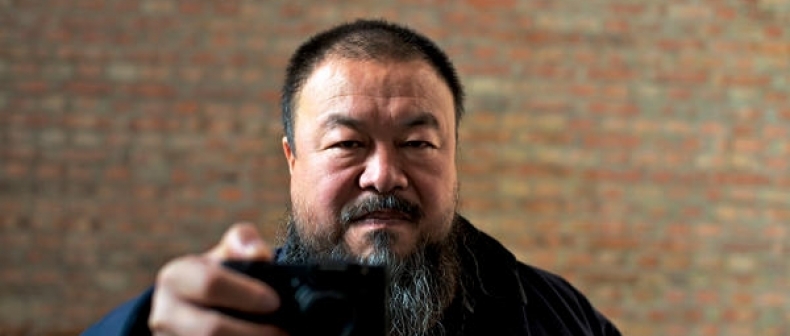
When Ai Weiwei was disappeared by the Chinese government, I was at his show in Berlin. It was the Gallery Weekend, an annual event where all the city’s galleries have their openings at the same time. The news of his disappearance had emerged earlier in the month and the opening of the show at his Berlin gallery was rammed with people. There were beefy security guards at every doorway, and a billboard-sized banner (designed by Rirkrit Tiravanija, no less) hung down the front of the building, reading “WHERE IS AI WEIWEI”.
The work in the show — a massive installation of dead trees and pottery that paid homage to traditional Chinese gardening and porcelain manufacturing — was the usual fare that Weiwei presents in Western galleries: stately, visually seductive, but nothing too meaty or immediately confrontational (at least, to my Western eyes). More interesting was the side-room, where the gallerist had installed a long table holding three binders filled with printouts of the gallery’s holdings of his back catalogue. A gallerina held watchful attendance with a sheaf of red dot stickers at the ready. People ambled through the installation at a respectful speed, but those price lists were where the action was.
There are ostensibly two Ai Weiweis: the monumental installation artist at the apex of his career in the Western art world; and the brash activist, who uses documentary video and social media to illuminate the machinations of a Kafkaesque bureaucratic regime. To those unfamiliar with his immediate context — his position within the Chinese art community, his relationship to Communist Chinese history — the relationship between these two is intriguing; they feed each other in strange and (as was in evidence at his Berlin show in 2011) sometimes uncomfortable ways. My curiosity about that relationship prompted me to see the new documentary, Ai Weiwei: Never Sorry (directed by Alison Klayman), and that curiosity was never satisfied.
The film is a character sketch of Weiwei at a particular moment: globally, he’s preparing for his participation in the Sao Paulo Biennial, installing his Sunflower Seeds at the Tate Modern’s Turbine Hall, and managing the creation of Remembering for Munich’s Haus der Kunst. Locally, he is coping with the fallout from his just-released documentary about the devastating 2008 Sichuan earthquake; the investigation of shoddy “tofu” construction of buildings in the province, and the government’s cover-up of the death toll. Due to that film, and his rallying of volunteers to persist in those investigations, he has become a folk hero and an enemy of the state. Klayman and her team track Weiwei as he attempts to bring a lawsuit against the Sichuan police after they assaulted him in his hotel room, where he was preparing to testify in defense of Tan Zuoren, another activist pursuing answers about the earthquake.
The film is empty, not because it lacks content, but because it is entirely devoid of context. Biographical details are glossed over with bullet-point brevity, and talking-head interviews raise many more questions than they answer. Those unfamiliar with Weiwei will find the film bewildering, and anyone who’s followed his career in any detail will find it frustratingly scant on insight. Instead of actually contextualizing him, mapping his rise to international prominence, trying to form a cohesive picture of his practice, drawing links between his documentaries, his publications, his media presence and his installations, the film settles for a bland and somewhat Orientalizing hagiography; Weiwei as an ornery 21st century Buddha. The film opens with him talking about a stray cat in his studio that has learned to open doors; “the difference between a cat and a person is that a cat will never close the door behind them,” quoth the Buddha. I can think of a couple of other differences, myself, and I can certainly think of more important topics for him to address onscreen.
The greatest mistake of the film is the lack of address of his output. Klayman is much more interested in Weiwei’s documentary work and Twitter feed. There is no attempt at a discussion of his gallery installations — the closest we get is a Chinese blogger, who tells us that his work is poetically transparent; everyone knows what that sculpture made of conjoined wooden stools signifies. Well, no, not if you’re unfamiliar with the folk traditions that Weiwei is apparently constantly referencing. Klayman cuts furiously between his grassroots activism at home and his glamorous jet-setting; given that, and the nigh-absence of meaningful artistic discussion, she unintentionally raises and unwittingly reinforces an uncomfortable notion: that Weiwei the activist is a means to raise the international profile (and therefore market value) of Weiwei the artist; and that the latter provides a comfortable shield from behind which the former can play the pied piper.
The film ends with his disappearance, narrated by a few intertitles. He was held at an undisclosed location for 81 days, apparently under investigation for tax fraud. His studio had, in the interim, been demolished at the insistence of the local authorities. We then see a haunted Weiwei return to his home, confronted by reporters, unable to tell them about his ordeal due to his bail conditions. It’s a frighteningly human moment: the Authority had finally punctured the safe bubble afforded him by his international reputation (and ultimately, that international reputation was what prevented him from vanishing permanently), and you can see it all in Weiwei’s face: the terror of the fact, the fear of it happening again, and the frustration at his muzzling. But the cataclysmic importance of this moment is lost, because it’s been preceded by an hour and a half of starfucking; Klayman has lost any notion of what this means for Wei Wei as an artist. Another intertitle reaches for a triumphant conclusion: Weiwei resumed tweeting two months later.
______
Sholem Krishtalka is the Toronto Standard’s art critic.
For more, follow us on Twitter at @torontostandard, and subscribe to our newsletter.











